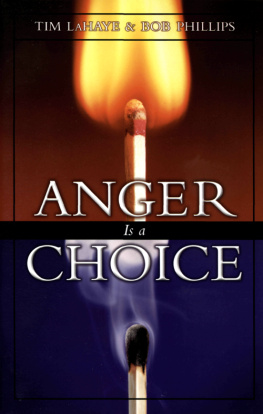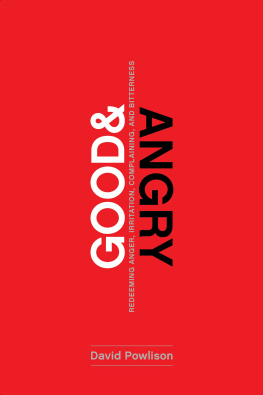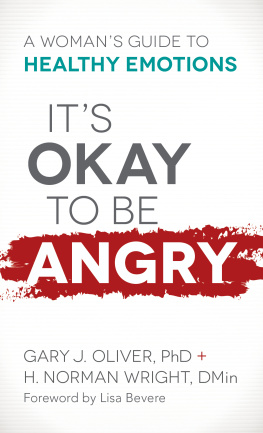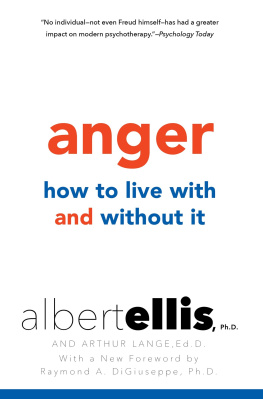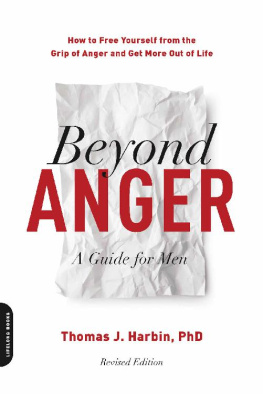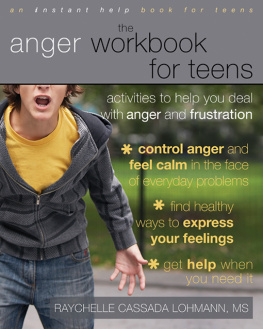
The author and publisher have provided this e-book to you for your personal use only. You may not make this e-book publicly available in any way. Copyright infringement is against the law. If you believe the copy of this e-book you are reading infringes on the authors copyright, please notify the publisher at: us.macmillanusa.com/piracy.
Lets face it, if anger-management techniques were effective, you wouldnt be reading this book. Youve probably tried it all: positive self-talk, punching a pillow, and reminding yourself that no good will come from getting angry. But the next time you feel your blood boiling or you start to fly into a blind range, see how well counting to ten works for you.
These clumsy attempts to maintain calmness are often futile and sometimes emotionally draining. Anger-management books typically feature these tried-and-not-true methods, along with generic case studies, personal anecdotes, and bumper-sticker slogans. The fact is, either something bothers us (causing anxiety, frustration, or anger) or it doesnt. Yes, our objective is to remain calm, but we can better accomplish this by not becoming agitated in the first place. When we fight the urge to blow up or melt down, we struggle against our own nature.
THE MILLION-DOLLAR QUESTION
What makes some people able to handle lifes ups and downs, the twists and turns, bumps and bruises with steadfast calm and composure, while others become incensed at the slightest insult, fall apart when facing a minor frustration, and blow out of proportion a mild disappointment?
In a word: perspective.
Imagine a small child playing with a toy that suddenly breaks. The childs whole world shatters, and she may respond by crying or becoming despondent, sad, or even angry. The child fails to appreciate, let alone recognize, all of the goodness in her life: that she is still being clothed, fed, loved, and taken care ofnot to mention that an entire world exists outside of her own smaller world. The childs parents know the broken toy has no real relevance because they have perspective that the child lacks.
Intellectually, we may recognize the unimportance and insignificance of whatever made us angry. Yet the qualities that most of us strive to exemplifysuch as objectivity and patienceare lost to frustration when, in a hurry, we encounter a checkout clerk with a trainee name tag staring at the cash register as if it were the cockpit of the space shuttle. We try to maintain our cool, but negative emotions surface and, once sparked, blaze. Now we face an uphill battle.
Perspective lies at the crux of our response and explains why we often feel irritated in the heat of the moment. After a few minutes, our anger subsides. A few hours later, we feel less angry, and in a few days, we wonder why we got so bothered in the first place. Time provides perspective, allowing us to see the situation with clarity. Likewise, as we grow and mature, we look back on our lives and realize that the summer camp we thought we must attend, the person we thought we must be friends with, or the office job we thought we must be offered are no longer musts . Without perspective, we are forever like a child with a broken toy.
THE MILLION-DOLLAR ANSWER
Mark Twain wrote, Comedy is tragedy plus time. When we discover how to shift our perspective, we see todays events through the wiser, more balanced lens of tomorrow. Once we can recognizein the momentwhat really matters, we no longer need to force ourselves to remain calm. Our thoughts, feelings, and responses to any situation reshape themselves. Negative emotions like impatience, insecurity, and anger dissolvenot because we fight to control our emotions but, rather, because we see the situation for what it really is.
Of course, the question we still face is, How do we manage what is relevant? Yes, we know we shouldnt sweat the small stuff, and the only reason we do is that we lack perspective. But what about serious things, such as an illness, an injustice, or a trauma? Objectively, they are a big deal. To handle such crises with equanimity, we learn to pull back the lens even further, to find peace of mind regardless of the present or pending situation; and gain the presence of mind to take responsible action.
Metaphorically speaking, typical anger-management tools are akin to weed killer: You have to keep spraying all of the time, every time, to keep weeds from sprouting upand no matter how vigilant you are, youll still miss plenty, and you are left exhausted. Never Get Angry Again explains how to pull up weeds by their roots by looking at realityourselves, our lives, and our relationshipswith optimum perspective and emotional clarity.
Through a comprehensive, holistic lens, we reveal and illuminate the causes and components of anger. These often include the gaping hole in our self-esteem due to a rotten (chaotic or traumatic) childhood, failing or failed relationships with those important to us, or living a life that lacks any real passion and joyall fueled by an undercurrent of resentment as we wonder, where is God in all of this? Life is unfair, so either Hes not in charge, He doesnt care, or He simply hates me. Not exactly self-esteem boosters or anger reducers.
Certainly, even with the proper perspective, we can get caught up in the moment. High-intensity situations can provoke us to throw reason and rationale right out the window, as our emotions erupt before we even know whats happening. Yet it doesnt have to be like this. Should an errant weed pop up under extreme circumstances, you can still maintain complete control. By using cutting-edge research from the field of neuroplasticity, you can literally rewire your brain to automatically take over, even when you feel as if youre losing your mind.
Now, as the saying goes, it takes two to tango. While a challenging life circumstance is one thing, the truth is, we wouldnt have to manage our anger if the people in our lives would manage their stupidity. Some folksfamily, friends, and coworkersjust push our buttons. In keeping with my penchant for the practical, you will learn step-by-step strategies to redraw boundaries, quash personality conflicts, and navigate difficult relationships to maintain (or reclaim) your sanity and eradicate a breeding ground for anger and frustration.
UNMASKING THE ENEMY
Various techniques will help us succeed in controlling our anger, but they cant create awareness. Only the complete recognition of the apparatusand the foolishness and futilityof anger will organically motivate us to keep our calm. For this reason, the first several sections of this book are descriptive; they explain the psychological dynamics of anger and of human nature. The latter sections are prescriptive, offering a range of psychological tools and techniques to win the ground war. But do not underestimate the power of understanding the enemy, anger. In any anger-provoking situation, we would love to ask ourselves, Why am I really getting angry? But of course, we cant ask the question because we arent thinking; we are only feeling. At that moment, nobodys home, and this is the fatal flaw in the tradition of anger management. However, when we wholly embrace the answer to this question with every fiber of our being before the situation arises, even when we lose perspective, the truth is baked into our very nature, and a calm and controlled response becomes second nature.
THE TAKEAWAY
Never Get Angry Again shows you how to permanently reorient your perspective. This will automatically take lifes little things right off your radar, and the big stuff will never again manifest as fiery fits of uncontrollable anger or rage, but instead be instantly viewed through the lens of authentic acceptance. Discover the easy way to live anger-free and never get angry againunless you want to.
Next page

